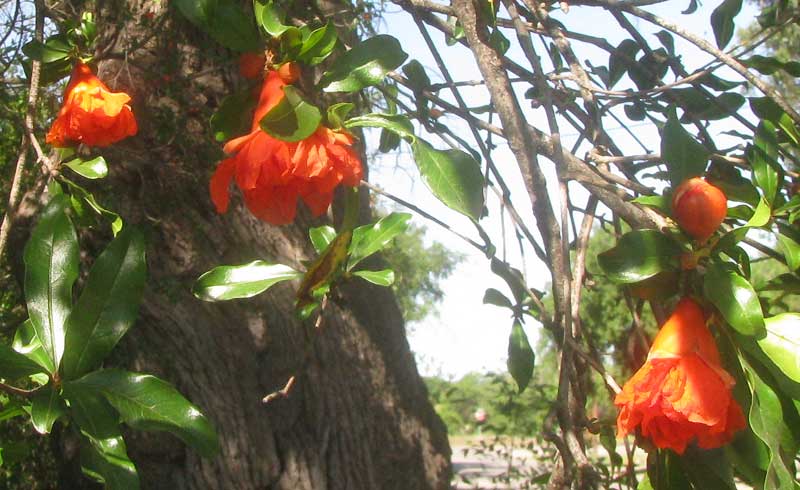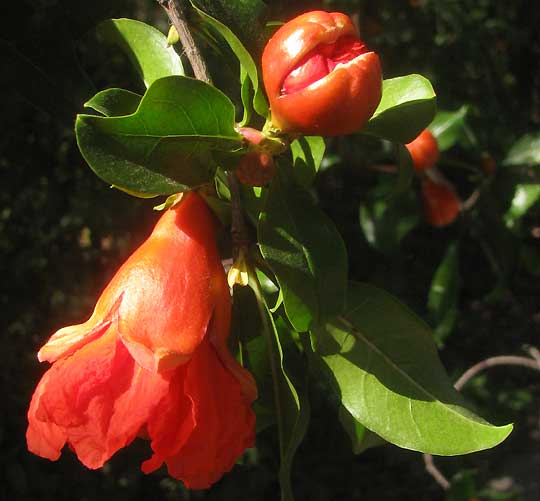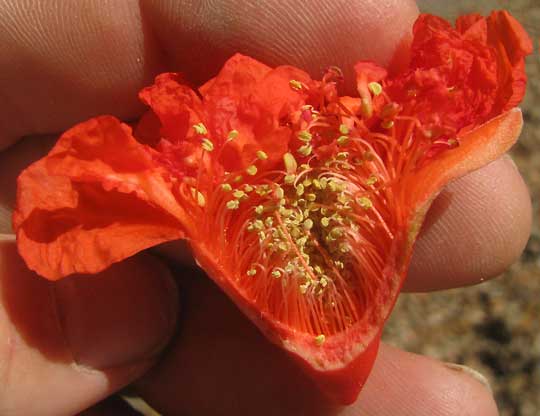Excerpts from Jim Conrad's
Naturalist Newsletter

from the May 4, 2014 Newsletter issued from the Frio Canyon Nature Education Center in the valley of the Dry Frio River in northern Uvalde County, southwestern Texas, on the southern border of the Edwards Plateau; elevation ~1750m (~5750 ft); N29.62°, W99.86°; USA
FLOWERING POMEGRANATE
Biking Uvalde's back streets is a pleasure if only to see the ornamental plants growing in people's yards. A small part of a ten-ft-high (2m), slender-branched bush that nowadays is one of the prettiest and most conspicuous flowering plants, usually growing amidst tall, dense hedges along streets, is shown above.
In that picture, the thick trunk behind the flowers belongs to an old liveoak; the flowering bush's trunk and branches are slender. A flower close-up is shown below:

In Mexico we've seen this plant a lot, but I was surprised to find it growing so well this far north. The large, red corollas arising from thick, leathery, red calyxes, along with those glossy, semi-leathery, simple leaves can only mean "Pomegranate," PUNICA GRANATUM.
However, flowers of Mexico's pomegranates normally display swollen bases below their calyxes, where the future pomegranate fruit will develop. These flowers' bases aren't at all swollen, so I'm guessing that they're a special ornamental "flowering pomegranate," of which the Web assures us that many cultivars exist, including "double-flowered" ones with blossoms looking like red carnations, and white-flowered and variegated ones. The different flowering varieties produce fruits of various sizes smaller than their fruiting trees, sometimes practically not developing fruits at all.
Certainly fruit-producing Pomegranate trees can be grown in our area. The Texas AgriLife Research and Extension Center at Uvalde disseminates a fruit-producing Pomegranate called "Spanish Sweet." Pomegranates are described as fruiting well in USDA Plant Hardiness Zones 8 to 10, and we're in Zone 8. It's iffy for colder Zone 7.
Pomegranate trees are members of the same family to which also belong Crape-Myrtle and Loosestrife, the Lythraceae. One field mark of that mostly tropical American family is that its species produce flowers in which the stamens, instead of arising from beneath the ovary the way seen in many flowers, are attached directly to the inner walls of the leathery calyx, as shown below:

In that picture also you can see that there's hardly any swollen ovary beneath the flower, so you'd not expect this flower to produce much of a fruit, if any fruit at all.